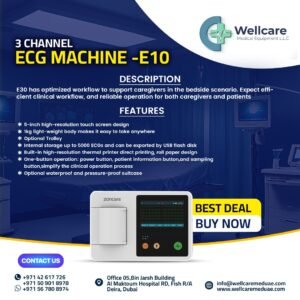Sterilization Chemical Indicator Strip Steam
In the healthcare sector, ensuring patient safety through proper sterilization is essential. Among the many sterilization tools available, chemical indicator strips play a vital role, particularly in environments using steam sterilization. At Well Care Medical Equipment LLC, we understand the critical importance of sterilization, offering high-quality Sterilization Chemical Indicator Strips that provide clear, reliable results to meet rigorous healthcare standards.
What Are Sterilization Chemical Indicator Strips?
Sterilization chemical indicator strips are single-use strips coated with chemicals that react when exposed to the specific conditions required for effective sterilization, such as temperature, pressure, and steam saturation. These strips are designed to undergo a color change when they reach the appropriate parameters for steam sterilization. This visual cue offers an instant verification, allowing staff to confirm that the sterilization process was effective before the equipment is used on patients.
The strips are often placed inside wrapped instrument packages, sterilization containers, or other enclosed areas within the autoclave (the steam sterilization chamber). They are invaluable for tracking whether critical equipment has reached sterilization standards and for documenting each cycle in line with regulatory guidelines.
Why Steam Sterilization?
Steam sterilization is one of the most widely used and effective sterilization methods in healthcare. Autoclaves use high-temperature, high-pressure steam to kill a broad spectrum of microorganisms, including bacteria, viruses, and spores. Steam sterilization is considered a “gold standard” for reusable medical equipment because of its rapid cycle time, cost-efficiency, and ability to penetrate porous surfaces and wrapped items. However, to ensure consistent results, it’s essential to confirm that each sterilization cycle reaches the correct temperature and pressure for a sufficient amount of time.
How Do Sterilization Chemical Indicator Strips Work?
Placement in Autoclave: The strip is placed in the sterilization chamber with the items being sterilized. Strategic placement, such as in the center of a packed item, is ideal to confirm that steam reaches all areas.
Chemical Reaction: As the autoclave reaches the target temperature and pressure, the chemical coating on the strip reacts to the heat and steam.
Color Change Indicator: The color change provides a straightforward confirmation that the sterilization parameters—temperature, pressure, and time—have been achieved. Typically, the color shift will indicate whether the strip has met the necessary thresholds for effective sterilization.
Verification by Staff: After the sterilization cycle, the strips are checked to ensure the color has changed as expected, verifying that the equipment is ready for safe use.
Types of Chemical Indicator Strips
Different classes of chemical indicator strips serve various monitoring levels to suit different regulatory standards and healthcare requirements:
- Class 1 (Process Indicators): These provide basic verification that the sterilization process occurred but do not verify specific sterilization conditions.
- Class 4 (Multi-Parameter Indicators): These monitor multiple conditions, like time and temperature, for a more comprehensive assessment.
- Class 5 (Integrating Indicators): The most advanced option, these strips measure all the critical parameters and provide high accuracy, offering results that are close in reliability to biological indicators.
Advantages of Using Sterilization Chemical Indicator Strips
Enhanced Safety for Patients and Staff: Proper sterilization is crucial for preventing infections and cross-contamination. Indicator strips offer an added layer of security by verifying that the necessary conditions for sterilization have been met.
Instant Verification: The color change provides an immediate confirmation of effective sterilization, allowing healthcare professionals to quickly verify equipment safety.
Cost-Effective and Accessible: Chemical indicator strips are affordable and easy to use, making them ideal for frequent use in healthcare settings without specialized training or equipment.
Regulatory Compliance: Many healthcare standards, such as those from the CDC and WHO, require proof of sterilization, and chemical indicator strips provide documented evidence for compliance.
User-Friendly: The strips are designed to be simple to interpret, allowing healthcare workers to confirm sterilization results with minimal effort.
Sterilization chemical indicator strips for steam sterilization are essential tools for healthcare facilities focused on patient safety and quality control. They offer a quick, visual way to confirm that equipment has been sterilized effectively, helping healthcare providers meet regulatory standards and maintain a safe, sterile environment for patients and staff. By incorporating these strips into their routine sterilization procedures, healthcare facilities can enhance their infection control measures and provide higher-quality care.




